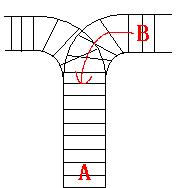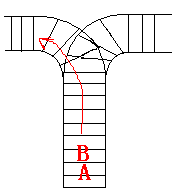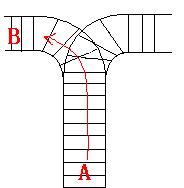


3 123 321 3 123 312
Yes. in in in out out out FINISH No. FINISHFor the first Sample Input, we let train 1 get in, then train 2 and train 3. So now train 3 is at the top of the railway, so train 3 can leave first, then train 2 and train 1. In the second Sample input, we should let train 3 leave first, so we have to let train 1 get in, then train 2 and train 3. Now we can let train 3 leave. But after that we can‘t let train 1 leave before train 2, because train 2 is at the top of the railway at the moment. So we output "No.".HintHint
#include<iostream>
#include<vector>
#include<stack>
using namespace std;
int main()
{
int n;
string str1,str2;
while(cin>>n)
{
cin>>str1>>str2;
vector<string>cmd;
stack<int>ls;
int cnt[100];
for(int i=0;i<str2.size();i++)
cnt[i]=str2[i]-'0';
int t=0;
for(int j=0;j<n;j++)
{
ls.push(str1[j]-'0');
cmd.push_back("in");
while(!ls.empty()&&ls.top()==cnt[t])
{
ls.pop();
t++;
cmd.push_back("out");
}
}
if(ls.empty())
{
cout<<"Yes."<<endl;
for(int i=0;i<cmd.size();i++)
cout<<cmd[i]<<endl;
}
else
cout<<"No."<<endl;
cout<<"FINISH"<<endl;
}
return 0;
}
#include<iostream>
#include<string>
#include<vector>
#include<stack>
using namespace std;
int main()
{
int n;
int cnt[100];
string str1,str2;
while(cin>>n)
{
vector<string>cmd;
cin.get();
cin>>str1>>str2;
stack<int>dict;
for(int i=0; i<str2.size(); i++)
{
cnt[i]=str2[i]-'0';
}
int c=0;
dict.push(str1[c]-'0');
cmd.push_back("in");
int t=0;
while(1)
{
int x=dict.top();
while(x==cnt[t])
{
loop:
cmd.push_back("out");
dict.pop();
if(!dict.empty())
{
int x=dict.top();
t++;
if(x==cnt[t])
{
goto loop;
}
}
else
{
t++;
break;
}
}
if(c+1==str1.size())
break;
dict.push(str1[++c]-'0');
cmd.push_back("in");
}
if(dict.empty())
{
cout<<"Yes."<<endl;
for(int i=0; i<cmd.size(); i++)
cout<<cmd[i]<<endl;
}
else
cout<<"No."<<endl;
cout<<"FINISH"<<endl;
}
return 0;
}
原文地址:http://blog.csdn.net/lsgqjh/article/details/46573297